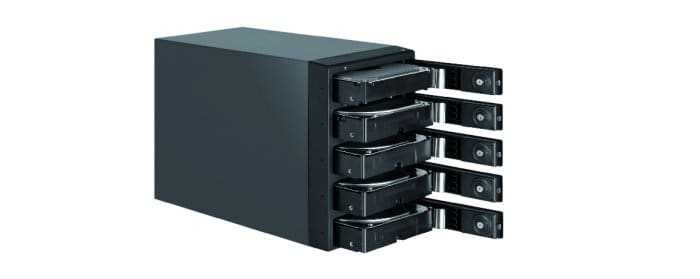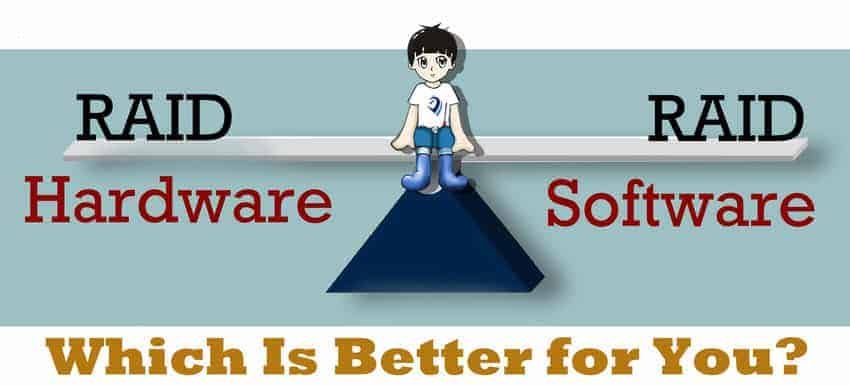Following our RAID article, we will now analyze with which tools we can create a RAID.

Because we suspect that your previous relative guide for beginners, which referred to the what is RAID, so in this article we will be more concise, but not without analysis, what is Softaware and what is Hardware RAID.
But for a better understanding of this article you should first read "What is RAID", since the present is a continuation of it. Take a deep breath and go.
What is Software RAID?
It is a program that uses computer resources, such as part of the CPU, μνήμηs etc, to handle all the calculations required for RAID operations. The more complex the RAID configuration, the more processing power required. In addition, the RAID disks are attached to your motherboard, so you should have a motherboard with enough slots for SATA disks.
Of course, it is also the most economical way to create a RAID. There are several preletteron the market that can do this job for you, for all operating systems. Either you have Linux, or Mac OS, or Windows.
Especially for Windows, from 8.1 onwards you do not need to install any software since the ability to create even RAID5 has been integrated into functional Microsoft system, within disk management. You will of course find many more features in the operating system Windows Servers. In Linux, the most common raid software is free Mdadm.
For:
- Software RAID, if not free, is at least cheaper than Hardware RAID in its original market. It allows you to perform all kinds of RAIDs, even combinations thereof, such as RAID10, 50, 60 or 100.
- Today's computers are so powerful, processors can easily handle RAID 0 and 1 editing without sharpening performance. And generally you will have no problem with parity that does not have parity, such as 0, 1, 10, and 01.
- The RAID Software allows us to take the entire array of drives from one computer and install it on another.
Against:
- Our motherboard should have several SATA ports so we can create the large combinations of RAID, such as 60 and 100, which require 8 drives each.
- RAID software runs on a particular operating system and a second operating system cannot see these drives. That is, if we run both Windows and Linux on our computer, and we have RAID installed on Linux, then Windows cannot see these disks.
- The performance of the computer is reduced if you use the most complex RAID configurations. For RAID5 you'll want to have at least one i5 machine. More generally RAID5 and above walk well on machines made for servers, with high processing power.
- Replacing the failed disk into RAID software is a bit more complicated. You should first tell your system to stop using the disc and then replace the disc. So, it's not as easy as replacing the disk in hardware RAID, where you simply remove the disc and put a new one.
What is Hardware RAID?
Hardware RAID is an internal card, such as a graphics card, or a card with extra USB ports, mounted on a slot on the motherboard.

In a Hardware RAID installation, the drives are attached to the RAID card, which is usually connected to the motherboard via a reception PCI or PCI-Express (PCI-e). This internal card, in addition to the ports, also contains the RAID controller and works equally well for large servers as well as for desktop computers.
There are also external RAID units that have a built-in controller card inside their system.

For:
- Hardware RAID has its own processor and memory, so it does not consume resources from our computer.
- Better performance, especially in more complex RAID configurations. The processing is done by the dedicated RAID processor instead of the main processor of the computer, which translates to less system pressure during backup and less disruption during data recovery.
- It has more RAID configuration options, including RAID combinations, which may not be available with some software RAID.
- Compatible with various operating systems. This is critical if you plan to access the RID from various operating systems running on your computer, for example from both Linux and Windows. The hardware RAID would be recognized by any system.
- Really easy to set up. Most RAID controllers will come with a menu wizard, given that you are not an expert to create the RAID array. At best, some are able to set up RAID automatically and correctly.
Against:
- It is not free! The card costs from prices ranging from 25 to 600 Euro, depending on the quality and level you want to work with. RID cards that support 0, 1 or 10 are relatively inexpensive, and if you want from RAID 5 and above the prices start from 150 euros.
- If the controller burns, it will require special software to retrieve the data, and it is not enough just to replace it.
- To better monitor the health and performance of your RAID system, you need to rely on the specific software provided by the card vendor only.
What is the Motherboard RAID?
There is also a third type of RAID. This is the ready RAID that offer some motherboards. However, although it sounds like hardware RAID, it is actually Software RAID or as it is customary to call it FakeRAID (false RAID).
FakeRAID is a BIOS software. The motherboard does not carry any special chipsets for RAID, and just the BIOS uses the computing power and memory of the motherboard to make all RAID calculations just like the Software RAID. Windows drivers also come with Windows drivers, which together with BIOS make the controller work.
Moreover, because the type of this RAID is set by the motherboard, if it burns then we will lose all our data, and only if we replace it with one whole we will retrieve them again. So after 5 years that your mother is likely to be burned, pray that there will be a stock at least one.
Finally, because it uses Windows drivers, it can only be set up in Windows operating system. In general, it only offers the disadvantages of Software RAID and additional trickle-bits, so you should not use it.
The only good thing with FakeRAID is that if you have it in your motherboard then your motherboard is of good quality !!!!
Find out what RAID suits you
Tough decision! There are 3-4 key selection criteria, but usually everyone moves with his personal choices.

For most of our readers who have a simple home computer, you usually do not have to spend money on buying a hardware and you are clearly staying at the free RAID software solution. If you only have two disks then you create a RAID1 and if you have three then RAID5 is what suits you.
Finally, if you want to play, then there is for you RAID0 that with two small SSD drives you can write ONLY your operating system and see your computer launch at speed. Be careful, however, we repeat that your data should be outside of RAID0. Why the SSD is messing up.





